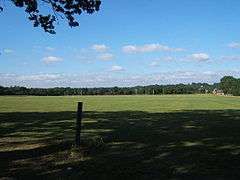Putney Vale
Putney Vale is a small community south of Roehampton Vale and apart from its cemetery which pre-dates its building by 60 years its set back by Roehampton Vale from the A3.
| Putney Vale | |
|---|---|
 Playing fields at Putney Vale | |
 Putney Vale Location within Greater London | |
| London borough | |
| Ceremonial county | Greater London |
| Region | |
| Country | England |
| Sovereign state | United Kingdom |
| Post town | LONDON |
| Postcode district | SW15 |
| Dialling code | 020 |
| Police | Metropolitan |
| Fire | London |
| Ambulance | London |
| London Assembly | |
Description
Political geography
Electorally and in local services since 1965, which it narrowly pre-dates, it has been part of the London Borough of Wandsworth and is currently part of "Roehampton" ward.
Housing
Built in the mid-1950s, this is an estate of light brick of local authority-built (mainly duplex, four-storey) maisonettes, spacious short terraces and semi-detached houses lined with trees, lawns, lit flagstone paths and parking. Today, most homes are in private hands, with the balance owned and let by the Borough.
Amenities
The non-denominational Putney Vale Cemetery & Crematorium, in which certain celebrities were or are commemorated is north and east. At its greatest width it reaches one third of the distance to where the very affluent Wimbledon Park and Putney Heath suburbs begin.
An Asda superstore is beyond a strip of the cemetery to the immediate north.
Allotment fruit and vegetable gardens, let by the Borough at low rates, are to the south-west, before which an outdoor basketball pitch and young children's playground.
At the south is a private school, Hall School Wimbledon.
Its curved access road, Stag Lane, sweeps past its very short row of shops and takeaways, beyond the superstore and cemetery into roads forming an elongated crescent with a smaller and squarer crescent.
History
A 1928 edition of Punch advertised KLG "'fit and forget' sparking plugs" manufactured where Asda stands, with contact numbers 2132 and 2133. KLG was founded by Kenelm Lee Guinness, part of the brewing dynasty, a noted early motor racer before developing highly reliable auto and aero spark plugs. The company grew from what was a disused pub, the Bald Face Stag, into works reputedly employing more than 1,500 people. After a serious motorsport accident Guinness gassed himself to death at his nearby home in 1937. He is buried in the cemetery.
Occasionally in parish history the point outside the cemetery formal, arterial road gates (seldom used) was known as Putney Bottom, at the base the long carriage incline to Tibbett's Corner at the top of Putney Heath.[1] It can be noted water drains westward through the extreme south and west of what became (after its much later than medieval separation from Putney) Roehampton parish, so known as Roehampton Vale where the A3 crosses it into the north-flowing Beverley Brook.[2]
Surroundings
Beyond relatively large green buffers – playing fields, a golf course, Richmond Park, Wimbledon Common and Putney Heath – and beyond adjoining Roehampton Vale, are:
- Roehampton Village
- Putney
- Southfields, a mainly residential area loosely associated with Wandsworth
- Kingston Vale followed by Norbiton and Kingston upon Thames
- Copse Hill, associated with Raynes Park
- Coombe Hill or Coombe, associated with New Malden
- Wimbledon Park, associated with Wimbledon Village
Kingston University Mechanical Engineering Faculty and privately owned housing, built in 1983 are on Friars Avenue, adjacent playing fields that form part of Wimbledon Common.
The Richardson Evans Memorial Playing Fields host Saturday/Sunday league football teams; where London Scottish and Cornish Rugby Football Clubs train. Annual schools rugby and women's football tournaments are also held there. There are four Wimbledon Common rangers cottages on Stag Lane and Friars Avenue. On the north east side of the playing fields, Stag Lane becomes a track called Kings Ride. The origin of the Kings Ride name is believed to date from when Henry VIII, while chase deer from Richmond Park would pursue them onto the common before the wall to the park was built. The tiny strip north of the junction between Stag Lane and the A3 is a conservation area and the red brick wall to Richmond Park: Grade II listed.
References
- Geikie, J. C. (1903). The Fascination of London: Hammersmith, Fulham and Putney. London: A & C Black, p84.
- Map of the parishes boundaries forming the Hundred of Brixton in Surrey throughout the medieval and Tudor times.
